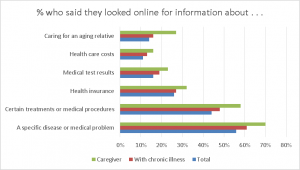
https://www.flickr.com/photos/heatherweaver/7981252259
For every person I talk to who says their parent or grandparent or aunt or uncle wants nothing to do with computers or the Internet, there seems to be a grandma taking the Internet by storm. It is true that computer use, Internet use, and mobile device use are lower among older adults than other age groups (especially among the “oldest old” defined as those 80 and older). That’s not surprising. Technology wasn’t part of the fabric of world when they were in school or the work force as it is now. While it seems younger folks need to make a conscious decision to disconnect, older adults may need to make a conscious choice to embrace technology.
Despite ageist stereotypes many older adults are choosing to do just that. Tech use among older adults is rising at an impressive clip. Four in ten older adults own a smartphone which is two times more than in 2013. Sixty-seven percent use the Internet.
What older adults apparently haven’t caught onto as quickly is gaming – 25% of adults 65 and older play video games compared to 50% of Americans age 18 and older and 67% of 18-29 year olds. Only 2% of older adults describe themselves as “gamers” compared to 22% of 18-29 year olds. (If you search online for “older gamer” you will find that means people in their 30s and 40s.)
The barriers to gaming among older adults are similar to the barriers for the use of other technology. They include access, attitudes, and ability. The data on Internet and smartphone use above suggest that access barriers are declining. However, some research suggests that adults are more likely to believe video games are a waste of time and older adults in particular may not want to be seen as childish (a perhaps natural reaction to society’s ageist tendency to infantilize older adults). And there are some potential issues with changes in eyesight, cognition, and motor abilities that may make fast-paced action games less popular for many older adults.
Much of what we know about gaming habits to date are based on surveys or focus group studies that ask about gaming habits and reactions to descriptions of games. These studies suggest that when older adults do play games they are less likely to play immersive action games. Computerized versions of card games, board games, and puzzles are more popular.
What’s missing is research that tracks actual gaming behaviors of older adults.
A recent study by an interdisciplinary team including researchers from psychology, engineering and kinesiology tracked gaming behaviors among a sample of 150 adults aged 65 and older over the course of a year. The study was a secondary analysis of data from a randomized controlled trial testing the effects on social isolation of a system called PRISM, or Personal Reminder Information and Social Management. The PRISM system was installed in participants’ homes and they were given three training sessions and follow up calls one week, three months, and nine months later. This study reports on usage data over the course of a year, specifically use of 11 single player video games that were part of the system. All of these games were computerized versions of card games, puzzles, etc. based on what previous research found older adults prefer.
Here is some of what they learned:
- Older adults played a game on 42% of the days they accessed the system. Games were one of the most used features after email and the Internet. Almost half of the sample (49%) had the equivalent of one month or more of days of game play.
- Solitaire was the most played game.
- There was a slight drop in activity over time, but gaming continued over the course of the entire year.
- There were distinct groups of participants:
- A group who played the most frequently and almost exclusively played Solitaire.
- A group who played Solitaire almost exclusively, but less frequently.
- A group who played a range of games.
- A group who used the system for fewer days on average than other participants and did not play many games.
- There were no clear predictors of game play except total number of days using the system. Not surprisingly, those who were in the system more played more.
- Game use the previous week predicted more non-game system use the following week.
That last point is something I find particularly interesting. It may simply be that those who used the system were going to use the system and those who used the system were also more likely to play games and keep using the system. It might also be, however, that having access to the games kept people coming back and while there they were more likely to use other parts of the system as well.
Why is this important?
Telehealth is a growing part of health care and can range from devices in the home to track and report health indicators like blood pressure or blood sugar to virtual doctor visits in rural areas. Telehealth has potential to improve access to care, not by replacing human interactions, but by facilitating the real time sharing of important information and timely communication with health care providers. While playing games to telehealth may seem like a stretch, for telehealth to work people need to be willing and able to interact with the technology tools (that includes the providers as well as the patients – perhaps a conversation for another day). This study suggests that including games or other reasons to log in might encourage some older adults to use other parts of telehealth technology as well.

